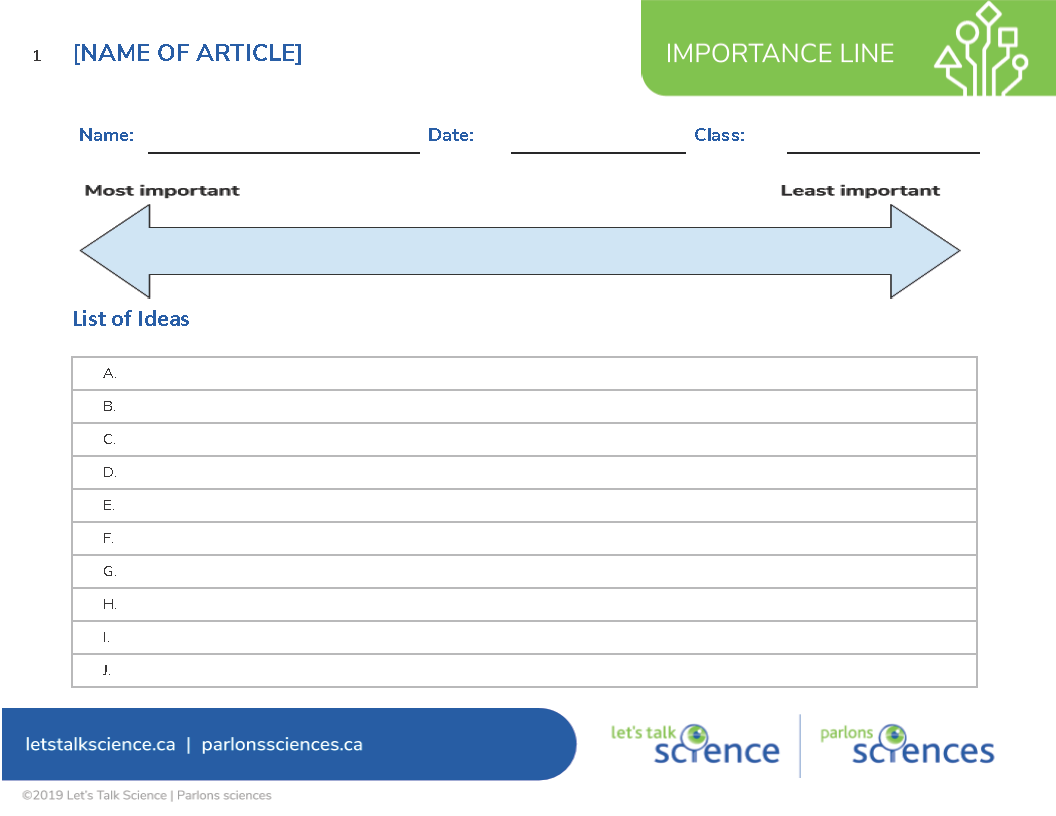Importance Line

Importance Line (mayrum, iStockphoto)

Importance Line (mayrum, iStockphoto)
How does this align with my curriculum?
PE
9
Science Grade 9 (revised 2018)
Decisions and Perspectives
PE
10
Science 421A (2019)
Decisions and Perspectives
PE
12
Chemistry 621A (draft 2021)
Decisions and Perspectives DP1
PE
11
Chemistry 521A (draft 2021)
Decisions and Perspectives DP1
This strategy helps students think critically about ideas by ranking them on a scale.
Why use it?
- To determine the relative importance of ideas in a reading or viewing selection
- To consolidate learning after reading or viewing new material
- To make judgments and justify thinking about a text or video
Tips for success
- The students do not need to find ten ideas; any number of ideas is fine.
- Use this strategy before a consolidation strategy such as the Key Ideas Round Robin strategy so that students can develop skills required for identifying key ideas in a text or video.
- Provide guidance as to where to find key ideas such as in the first or last sentences in a paragraph and in the first or last paragraphs on a page.
- What is important to a reader/viewer is based on experiences. It is acceptable for students to rank the ideas differently as long as they can justify their ranking with supporting evidence, connections to other texts, etc.
How do I use it?
- Provide each student with a blank Importance Line reproducible (see image at right).

- After reading or viewing the article/video, have the class brainstorm what they think are the key ideas in the text/video. Each student can record these on the lines on the Importance Line Template.
- Using this class-generated list, students can then individually rank the ideas from least to most important and place the LETTERS which represent the various ideas along the arrow (Importance Line).
- Afterwards, students can share and explain the rationale for their rankings with a partner and/or the class.
Extensions
- Take the students’ responses and compile a class Importance Line. Was there any agreement on which statement was the most important?
Using this Strategy
- Importance Line Reproducible Template [Google doc] [PDF]
- Facial Recognition and the Brain : Importance Line Reproducible [Google doc] [PDF]
- How Does Nuclear Energy Work?: Importance Line Reproducible [Google doc] [PDF]
-
What causes hot things to glow? : Importance Line Reproducible [Google doc] [PDF]
Create Your Own
- Importance Line Reproducible Template [Google doc] [PDF]
Ready to Use
- Facial Recognition and the Brain : Importance Line Reproducible [Google doc] [PDF]
- How Does Nuclear Energy Work?: Importance Line Reproducible [Google doc] [PDF]
-
What causes hot things to glow? : Importance Line Reproducible [Google doc] [PDF]
References
Ontario Ministry of Education. (2003). Think literacy cross-curricular approaches, grades 7-12. Ontario Ministry of Education.